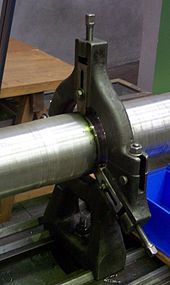Bezel (turning)
The steady rest , also known as a steady rest , is a device for supporting long workpieces when turning and grinding .
description
If the length of a workpiece (ratio of diameter to length over 1: 6) or its strength does not allow machining without offset or bending, a steady rest is used instead of a tailstock to work into the end of the shaft. This is the rule , especially with long, slim parts such as shafts , axles or threaded spindles . Turning, milling and grinding are the typical areas of application.
If so desired, because of the shape of the workpiece, the use of a centering is not possible or not sufficient, the use of a bezel is necessary. When machining long workpieces, vibrations can also easily occur . These lead to a wavy patterned surface of the workpiece ( chatter marks ), increased wear and tear on the spindle bearings and noise pollution. In addition, due to the machining forces, the turning tool may then press the workpiece out of the axis of rotation, whereby the geometry of the workpiece becomes faulty.
The working range of steady rests and roller blocks ranges from 10 to 2000 millimeters in diameter and a load capacity of 1 kg to 100 tons.
Bezel types
Fixed and moving bezels
The moving bezel is attached to the slide and enables continuous machining and thread cutting , for example . Fixed bezels are available with a foldable , removable or swiveling top .
Long, thin workpieces are supported with a fixed steady rest so that they do not bend during processing. It is also used when a long workpiece is to be machined from the front, e.g. B. when drilling or thread cutting with the tap . The steady rest is on the slide tracks of the rotary machine bed mounted. When applying the support jaws, the workpiece must run precisely . To prevent seizure between the support jaws and the workpiece, these are made of hardened steel or covered with plates made of a copper-tin alloy ( bronze ), hard metal or plastic. Steel rollers are also often used.
C-shape bezels
C-shaped bezels have a complex structure and are usually used with several consecutive and with several snug fits. In this way, particularly long, slim shafts can be machined, which are thus superbly protected against deflection. The C-shaped bezel combines the characteristics of a moving with that of a fixed bezel.
Ring bezels
Ring bezels are designed for slim and raw workpieces. With a ring bezel, for example, forged pieces can be clamped directly without having to turn a bezel seat beforehand. Likewise, bent or warped shafts can be accommodated without pre-turning.
The ring bezel consists of an outer part that is screwed to the machine tool and an inner part that can be rotated in large ball bearings within the outer part. The exact rotation of the workpiece is thus ensured by the ball bearing of the ring steady. The workpiece itself is in the inner ring such as in a four jaw chuck through four sleeves clamped. The surface and roundness of the workpiece therefore have no influence on the turning result.
The ring bezel can be positioned in the middle of the workpiece as a support. The axis position is checked with appropriate means and, if necessary, corrected by tensioning in the steady rest. Then work is carried out from right and left to the bezel. Before changing sides, the ring bezel can be clamped onto the freshly machined shaft. To make repositioning easier, larger ring rests have a manual or electric drive for moving on the machine bed.
This type of steady rest also absorbs vibrations from the machining process so that production can be carried out more precisely or with greater metal removal rates.
Ring rests are also predestined for the internal machining of tubes, where the outer surface can remain unmachined due to the design.
Grinding bezels
With grinding steady rests, clamping jaws are used instead of rollers, which are usually made of diamond or hard metal. Although this can have a negative effect on the workpiece surface in individual cases (heat generation), this is often accepted in order to guarantee a long service life and dimensional accuracy of the clamping jaws . In special cases, grinding also takes place in the seat of the steady rest and goes up to a concentricity of 2 µm.
Roller blocks
Roller blocks are suitable for workpieces up to the double-digit ton range and diameters of two to three meters - for example for ship shafts. Due to the weight of the workpiece, no roll from above is necessary.
The supporting roller block is attached behind the lathe on a guide track that is embedded in the floor and moved as required. In the position that the user would like to move to, the roller block is firmly connected to the floor using two clamping screws.

